| کد مقاله | کد نشریه | سال انتشار | مقاله انگلیسی | نسخه تمام متن |
|---|---|---|---|---|
| 5752538 | 1620207 | 2017 | 40 صفحه PDF | دانلود رایگان |
عنوان انگلیسی مقاله ISI
Petrological record of CO2 influx in the Dongying Sag, Bohai Bay Basin, NE China
دانلود مقاله + سفارش ترجمه
دانلود مقاله ISI انگلیسی
رایگان برای ایرانیان
کلمات کلیدی
موضوعات مرتبط
مهندسی و علوم پایه
علوم زمین و سیارات
ژئوشیمی و پترولوژی
پیش نمایش صفحه اول مقاله

چکیده انگلیسی
Dawsonite occurs in sandstones of the fourth member of the Shahejie Formation, Dongying Sag, Bohai Bay Basin, northeastern China. The paragenesis sequence, formation temperatures, carbon dioxide (CO2) and aqueous medium origin of dawsonite from the Binnan Area were studied to understand the formation of dawsonite, as a possible mechanism for mineral trapping of CO2 in carbon capture and storage (CCS) programs. The petrological and geochemical characteristics of the dawsonite-bearing sandstones were identified using polarizing microscope examination, scanning electron microscope, X-ray fluorescence, X-Ray diffraction and stable isotopic analyses. The paragenesis sequence of the authigenic minerals are mainly quartz overgrowth - early-stage calcite (A) - ferrocalcite- dawsonite - late-stage calcite (B) - ankerite - siderite. The carbon and oxygen isotope compositions of dawsonite reveal that δ13C values of dawsonite range from â2.27â° to +3.50â°, indicating inorganic CO2. The calculated δ13C values of CO2 gas in isotopic equilibrium with dawsonite range from â7.2â° to â1.6â°, suggesting that CO2 originated mainly from degassing of mantle-derived magmas and partly from thermal decomposition of carbonate rocks, as supported by regional magmatic activities, rifting, and observation of carbonate during drilling in well Bin76. The δ18O values of dawsonite vary from +17.2â° to +19.8â°, and the calculated δ18O values of H2O in isotopic equilibrium with dawsonite range from â2.1â° to +0.4â°. The mixed aqueous medium was mainly connate water, influenced by magmatic activities and meteoric water influx during the formation of dawsonite. According to oxygen isotope data, the formation temperatures of dawsonite in the Binnan Area range from 77 °C to 95 °C, which are consistent with the estimated paleo-temperatures (79 °C to 85 °C), indicating that the dawsonite formed at the late stage of the diagenetic phase.
ناشر
Database: Elsevier - ScienceDirect (ساینس دایرکت)
Journal: Applied Geochemistry - Volume 84, September 2017, Pages 373-386
Journal: Applied Geochemistry - Volume 84, September 2017, Pages 373-386
نویسندگان
Fulai Li, Wenshuai Li,